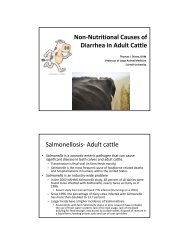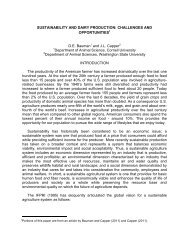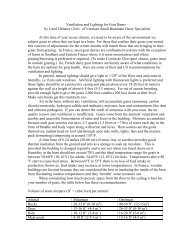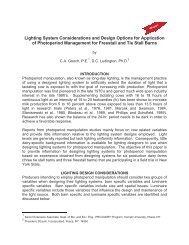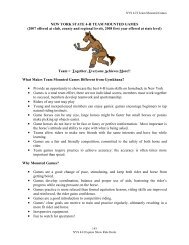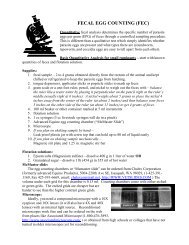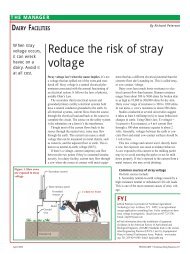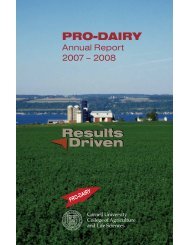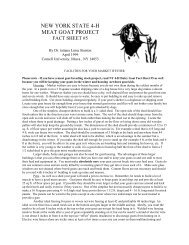2009 Proceedings of the Cornell Nutrition Conference For Feed ...
2009 Proceedings of the Cornell Nutrition Conference For Feed ...
2009 Proceedings of the Cornell Nutrition Conference For Feed ...
You also want an ePaper? Increase the reach of your titles
YUMPU automatically turns print PDFs into web optimized ePapers that Google loves.
Table 3. Reactive Lys content <strong>of</strong> intact<br />
and rumen undegraded residue<br />
blood meal samples determined<br />
using <strong>the</strong> homoarginine method<br />
(Boucher, 2008)<br />
Intact sample<br />
Reactive<br />
Lys, %<br />
Bovine BM1 96.66<br />
Bovine BM2 93.05<br />
Heated bovine BM 96.20<br />
Porcine BM1 96.52<br />
Porcine BM2 92.59<br />
Heated porcine BM<br />
Rumen undegraded<br />
residue<br />
94.37<br />
Bovine BM1rr a<br />
66.98<br />
Bovine BM2rr 72.56<br />
Heated bovine BMrr 45.30<br />
Porcine BM1rr 71.30<br />
Porcine BM2rr 93.12<br />
Heated porcine BMrr 86.83<br />
RUP-Lys dig. vs.<br />
reactive RUP-Lys b R 2 = 0.05<br />
Lys dig. vs. reactive Lys c R 2 = 0.29<br />
a rr = rumen residue.<br />
b Digestibility <strong>of</strong> lysine in rumen<br />
undegraded protein (RUP) determined<br />
in roosters and reactive lysine in RUP<br />
determine via <strong>the</strong> homoarginine<br />
method.<br />
c Lysine digestibility determined in<br />
roosters and reactive lysine<br />
determined via <strong>the</strong> homoarginine<br />
method.<br />
Ohio State Modifications <strong>of</strong> <strong>the</strong> Three-step<br />
Procedure<br />
In <strong>the</strong> previously described analysis <strong>of</strong> in<br />
vitro AA digestibility <strong>of</strong> BM samples, it is<br />
recognized that <strong>the</strong> sample size (n = 6) is<br />
small. In a more extensive analysis <strong>of</strong> RUP<br />
digestibility, 265 blood meal samples were<br />
evaluated using <strong>the</strong> 3-step in-situ/in-vitro<br />
method described by Calsamiglia and Stern<br />
(1995) with modifications (Table 4; St-Pierre,<br />
unpublished observations). Considerable<br />
inter-assay and inter-lab variation was<br />
observed when <strong>the</strong> original Calsamiglia and<br />
Stern (1995) procedure was applied to BM.<br />
Therefore, <strong>the</strong> following modifications were<br />
made at Ohio State: (1) partial<br />
standardization <strong>of</strong> enzymes, (2) use <strong>of</strong> fuzzy<br />
standards (i.e., standards whose analytical<br />
values are not precisely known), correction<br />
for wash-out, and (3) Bayesian statistics to<br />
adjust for inter-assay variation. Using <strong>the</strong>se<br />
modifications, <strong>the</strong> inter-assay variation was<br />
reduced five fold compared with <strong>the</strong> original<br />
3-step procedure. Amino acid digestibilities<br />
were corrected such that <strong>the</strong> sum <strong>of</strong> all<br />
digestible AA was equal to <strong>the</strong> adjusted<br />
digestible protein. While <strong>the</strong> CP and RUP<br />
averages (Table 4) were similar to those<br />
reported for ring-dried blood meal in <strong>the</strong> NRC<br />
2001, <strong>the</strong> RUP digestibility <strong>of</strong> 64.6% (Table<br />
4) was lower than <strong>the</strong> NRC (2001) library<br />
value <strong>of</strong> 80%. Amino acid digestibilities were<br />
similar to RUP digestibility with <strong>the</strong> exception<br />
<strong>of</strong> lysine, which was lower (56.0 + 27.1%;<br />
data not shown).<br />
While heating <strong>of</strong> BM can increase its RUP, heating does not consistently alter <strong>the</strong><br />
digestibility <strong>of</strong> <strong>the</strong> RUP once it arrives at <strong>the</strong> small intestine. This concept is clearly<br />
demonstrated in Figure 3, because <strong>the</strong>re is no relationship between <strong>the</strong> amount <strong>of</strong> RUP<br />
and RUP digestibility as measured in <strong>the</strong> Ohio State modified 3-step procedure.<br />
Figure 4 clearly demonstrates that Lys digestibility <strong>of</strong> BM was almost always<br />
lower than digestibility <strong>of</strong> RUP, and as <strong>the</strong> RUP digestibility <strong>of</strong> BM decreased RUP-Lys<br />
digestibility <strong>of</strong> BM decreased even more. Therefore, <strong>the</strong> amount <strong>of</strong> MP-Lys supplied to<br />
<strong>the</strong> animal when BM is fed can be substantially less than predicted by ruminant nutrition<br />
23



